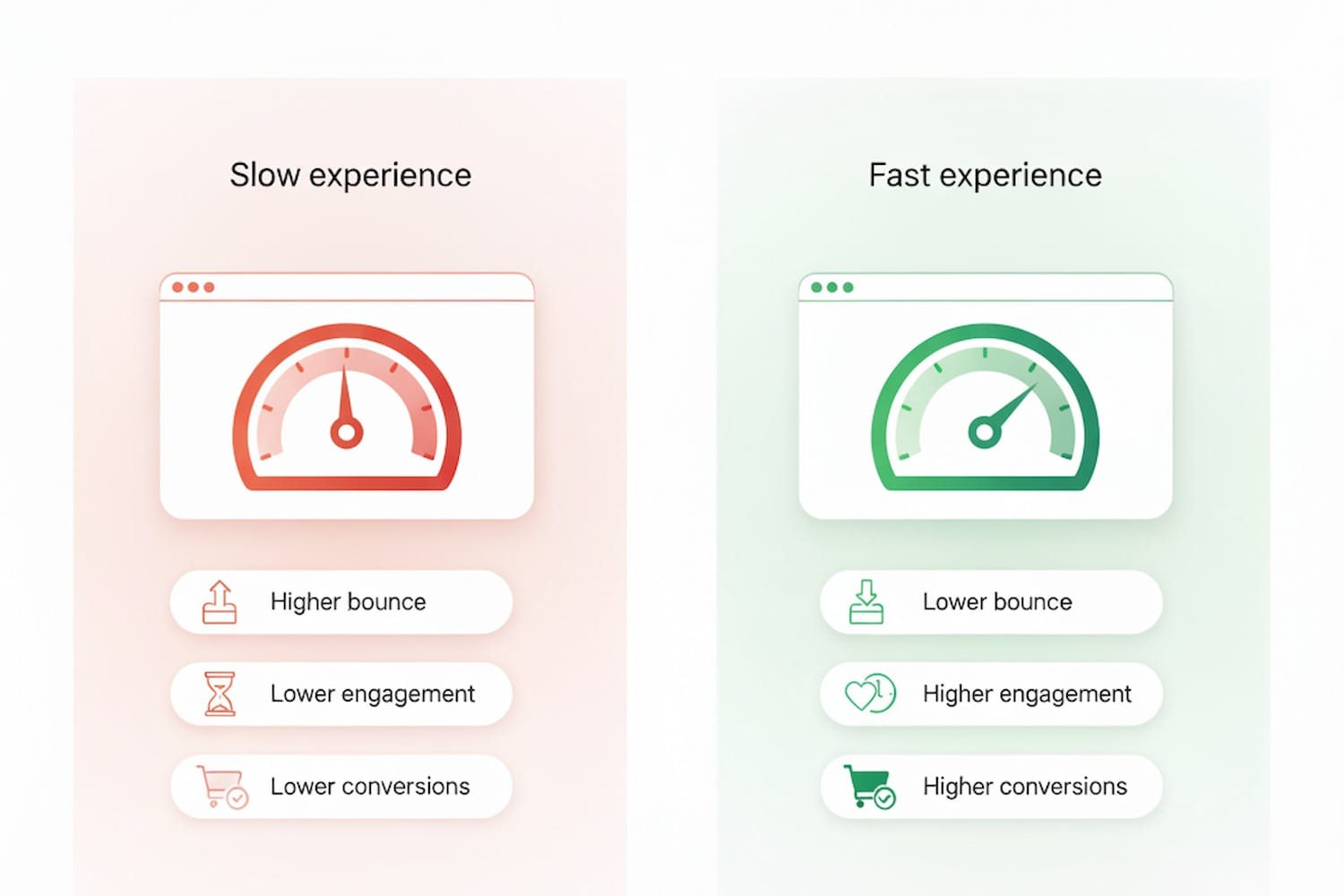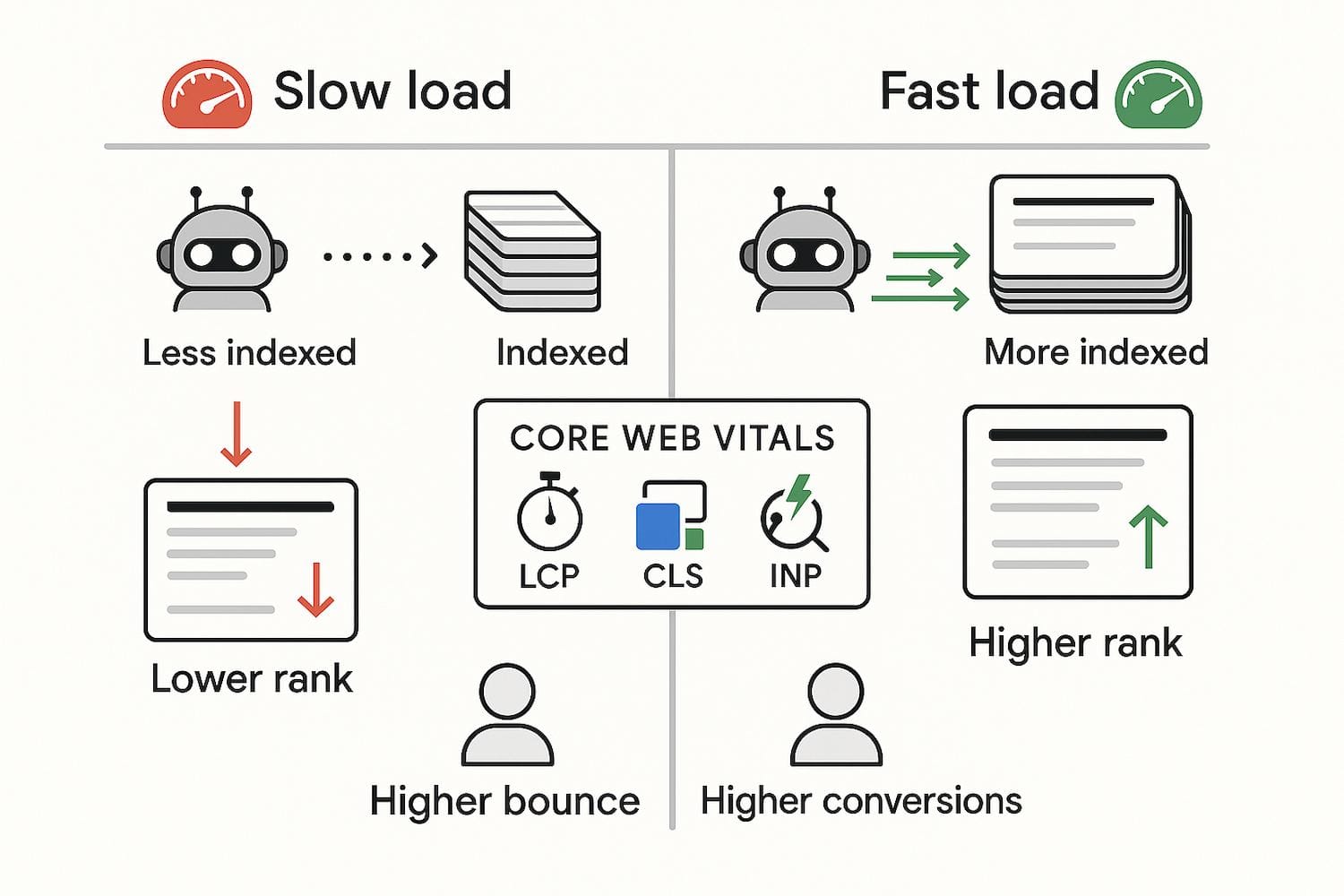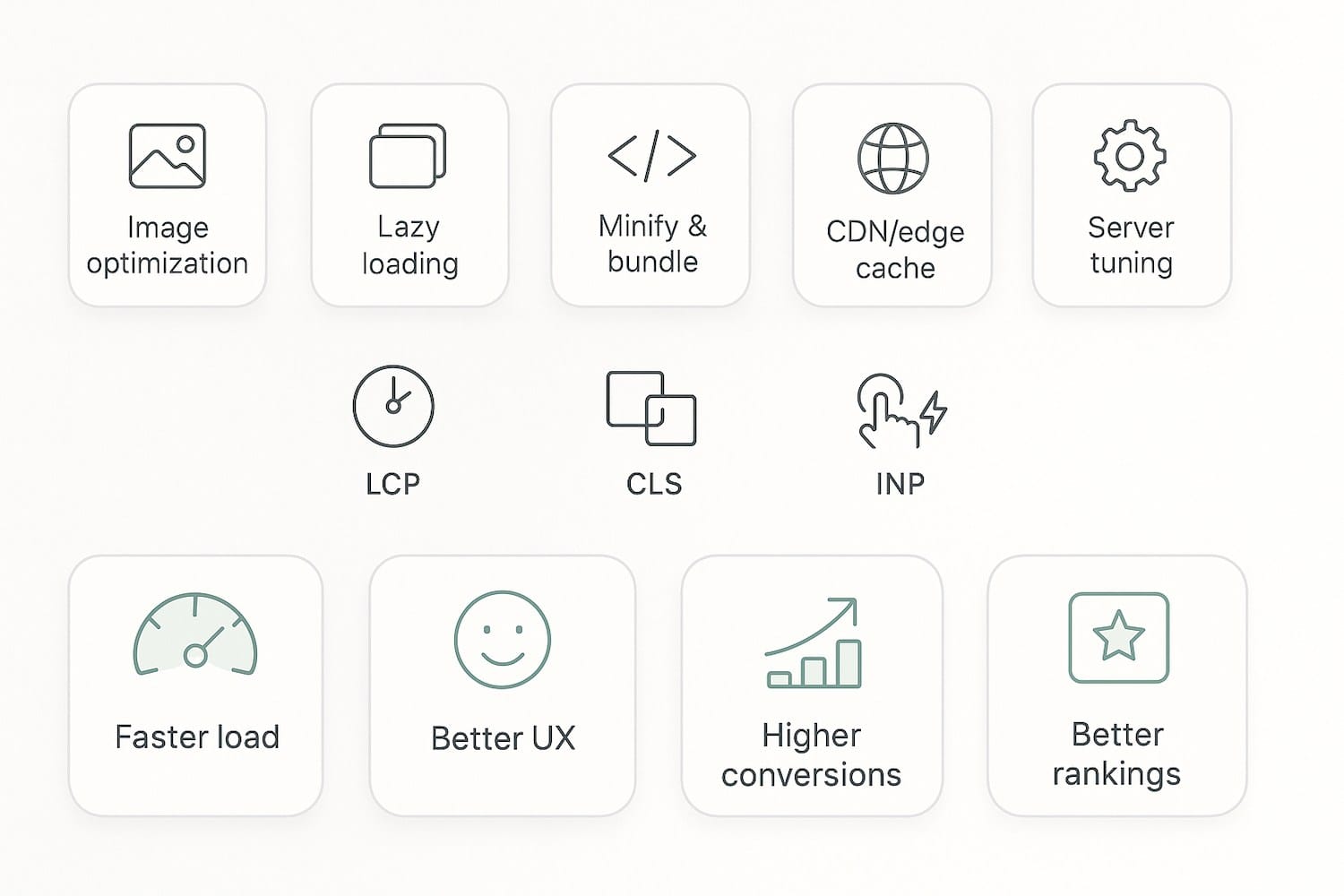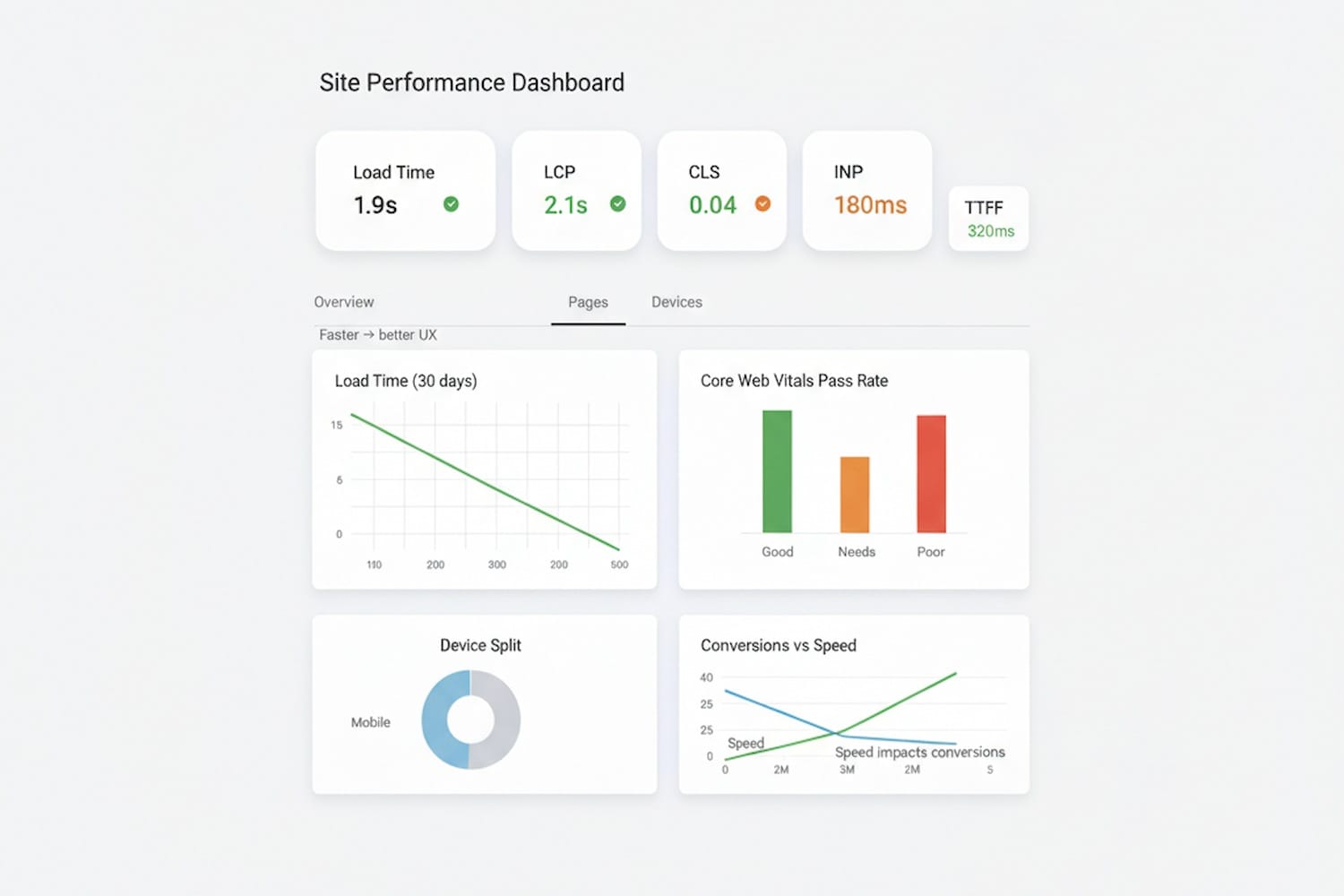How Website Speed Impacts Conversions and SEO: What You Should Do About It
Your website’s loading speed isn’t just a technical metric—it’s directly connected to your bottom line and search rankings. Every millisecond counts when users decide whether to stay on your site or bounce to a competitor. The relationship between website speed, conversion rates, and SEO performance has never been more critical, with Google’s algorithm updates and increasingly impatient users demanding instant experiences.
This comprehensive guide reveals exactly how website speed impacts both conversions and SEO, backed by real data from industry leaders and billions of user sessions. More importantly, you’ll discover actionable strategies to optimize your site’s performance and measurable improvements you can implement today.
Key Takeaways
- A 1-second delay in page load time can reduce conversions by 7% and bounce rates increase by 32% when load time goes from 1 to 3 seconds
- Google uses Core Web Vitals (LCP, INP, CLS) as ranking factors, making page speed essential for SEO visibility
- Companies like Vodafone saw 8% more sales and Rakuten 24 achieved 33% higher conversion rates by optimizing website speed
- The ideal page speed is under 3 seconds, with top-performing sites loading in 1.65 seconds or less
- Key optimization strategies include image compression, caching, CDN implementation, and Core Web Vitals improvements
The Direct Impact of Website Speed on Conversion Rates
The numbers don’t lie: speed affects your conversion rate more than almost any other factor. According to Google’s extensive research, 53% of mobile users will abandon a site if it takes longer than three seconds to load. This abandonment rate remains consistent across industries, making page load speed a universal concern for any business with an online presence.
Statistical analysis reveals that every 100ms improvement in loading times can boost conversions dramatically. Travel sites see 10.1% conversion improvements, eCommerce platforms experience 8.4% increases, and luxury brands achieve 3.6% conversion gains per 100ms improvement. These aren’t marginal gains—they represent significant revenue opportunities hiding in your website’s performance metrics.
User behavior patterns show that 47% of consumers expect websites to load in 2 seconds or less. The tolerance threshold drops even further for repeat visitors, who develop higher expectations based on their previous experience with your brand. When users encounter slow loading times, they don’t just leave—they form negative impressions that impact future purchasing decisions.


The mobile versus desktop conversion differences reveal another critical insight. Mobile users typically abandon sites after 6-10 seconds compared to just 3 seconds on desktop devices. This patience gap occurs because mobile users often browse in situations with limited time or attention, making fast loading times even more crucial for mobile conversion optimization.
Revenue impact calculations demonstrate the real-world cost of slow speeds. A site generating $100,000 daily can lose $2.5 million annually from just one second of delay. Even smaller businesses feel the impact—retail sites collectively lose $2.6 billion in sales annually due to speed-related abandonment.
Real-World Case Studies: Speed to Revenue Success Stories
Major brands have documented substantial revenue increases through speed optimization initiatives. Vodafone achieved a 31% improvement in their Largest Contentful Paint (LCP) metric, resulting in an 8% increase in sales conversions. This improvement came from optimizing their mobile version and reducing render blocking resources that delayed above the fold content.
Rakuten 24’s comprehensive Core Web Vitals optimization produced a 33.13% conversion boost across their platform. Their approach focused on improving all three core web vitals simultaneously, demonstrating that holistic performance improvements deliver better results than isolated fixes.
redBus, a leading travel booking platform, achieved 7% sales growth by specifically targeting their Interaction to Next Paint (INP) scores. They reduced delays in interactive elements, allowing users to complete desired actions faster and reducing friction in their booking funnel.
Akamai’s analysis of over 10 billion visits confirmed that a 100ms delay correlates with a 7% conversion rate drop across industries. This massive dataset provides compelling evidence that even imperceptible speed improvements impact user behavior and business outcomes.
How Website Speed Affects SEO Rankings
Google’s algorithm treats page speed as a confirmed ranking factor since the 2021 Page Experience Update. Core Web Vitals now directly influence search results, with faster sites gaining competitive advantages in search engine rankings. The three metrics—Largest Contentful Paint, Interaction to Next Paint, and Cumulative Layout Shift—measure real user experience and correlate strongly with organic traffic performance.
Speed affects crawl budget allocation, determining how efficiently search engines can index your content. Faster sites allow Google to crawl more web pages during each visit, improving indexation rates for new content and updates. Large eCommerce sites and content publishers particularly benefit from improved crawl efficiency, as it enables better visibility for their entire catalog.


Mobile-first indexing considerations make speed optimization even more critical. Google primarily uses the mobile version of websites for ranking and indexing decisions. Sites that load fast on mobile devices gain significant advantages in search results, while slow mobile experiences can hurt rankings even if desktop performance is excellent.
The correlation between page speed and SERP positions shows that faster sites consistently rank higher than slower competitors. While speed isn’t the only ranking factor, it provides a measurable advantage that compounds with other SEO efforts. Sites that pass Core Web Vitals assessments are more likely to rank in competitive verticals.
Understanding Core Web Vitals for SEO Success
Largest Contentful Paint (LCP) measures loading performance and should target under 2.5 seconds for good user experience. This metric focuses on when the largest content element becomes visible, typically the main image or text block above the fold. Improving LCP requires optimizing server response times, render blocking resources, and resource load times.
Interaction to Next Paint (INP) replaced First Input Delay as of March 12, 2024, measuring responsiveness throughout the page lifecycle. Sites should aim for INP scores under 200ms to ensure smooth interactive elements. This metric captures the delay between user interactions and visual feedback, directly impacting perceived performance.
Cumulative Layout Shift (CLS) measures visual stability and should maintain scores under 0.1 to prevent unexpected layout shifts. Poor CLS scores occur when page elements move during loading, causing users to accidentally click wrong buttons or lose their reading position. Common causes include images without dimensions, dynamic content insertion, and web fonts loading.
Field data versus lab data comparison reveals why real user metrics matter more than synthetic testing. Field data reflects actual user experiences across different devices, network conditions, and geographic locations. Lab data from tools provides controlled testing environments but may not represent real-world performance variations.
Essential Website Speed Optimization Strategies
Image optimization forms the foundation of speed improvements for most websites. Converting images to modern formats like WebP or AVIF can reduce file size by 25-50% without quality loss. Implementing lazy loading ensures images only load when users scroll to them, dramatically improving initial page load times for content-heavy sites.
Server and hosting optimization provides the technical infrastructure for fast loading times. Choosing hosting providers with solid-state drives, optimized server configurations, and strategic server locations reduces Time to First Byte (TTFB). Geographic proximity between servers and users significantly impacts loading speed, especially for global audiences.
Code optimization through minification removes unnecessary characters from JavaScript and CSS files, reducing their size and improving load speed. Removing render blocking resources prevents external scripts from delaying page rendering. Critical CSS inlining ensures essential styles load immediately while non-critical styles load asynchronously.


Caching strategies multiply the impact of other optimizations by storing processed content for faster delivery. Browser caching reduces repeat load times for returning visitors, while server-side caching eliminates processing delays for dynamic content. Proper cache headers ensure optimal balance between fresh content and performance gains.
Advanced Performance Optimization Techniques
Content Delivery Network (CDN) implementation distributes static assets across global server networks, reducing latency regardless of user location. CDNs cache images, stylesheets, and scripts closer to users, often improving load times by 30-50% for international audiences. Modern CDNs also provide additional optimization features like automatic image compression and format conversion.
Font optimization through subsetting, preloading, and strategic web font display prevents text rendering delays. Font subsetting includes only necessary characters, reducing file sizes. Preloading critical fonts ensures text appears immediately, while font-display strategies control how browsers handle font loading delays.
JavaScript optimization using async and defer attributes prevents scripts from blocking page rendering. Code splitting breaks large JavaScript bundles into smaller pieces that load as needed. Tree shaking removes unused code from production builds, reducing overall bundle sizes and improving performance.
Third-party plugin audits identify performance bottlenecks from external services and widgets. Each additional third-party script typically adds 34 milliseconds to load times, making careful evaluation essential. Removing unnecessary plugins and optimizing remaining integrations can significantly improve overall performance.
Measuring and Monitoring Website Speed Performance
Google PageSpeed Insights provides comprehensive analysis combining lab data and field data from real users. The tool reports Core Web Vitals scores and specific optimization recommendations prioritized by potential impact. Regular PageSpeed Insights testing helps track improvements and identify new performance issues.
GTmetrix offers detailed waterfall charts showing exactly how each page element loads and where delays occur. The platform tests from multiple locations and provides historical data to track performance trends over time. GTmetrix’s performance recommendations include specific technical implementations for each optimization opportunity.
Lighthouse audits provide in-depth analysis of web pages across performance, accessibility, and SEO metrics. The tool simulates various network conditions and device capabilities, helping identify performance issues across different user scenarios. Lighthouse’s performance budget features alert teams when pages exceed size or speed thresholds.
Key metrics to track include Time to First Byte (TTFB), First Contentful Paint (FCP), Largest Contentful Paint (LCP), Interaction to Next Paint (INP), and Cumulative Layout Shift (CLS). Each metric correlates with specific aspects of user experience and conversion performance, enabling targeted optimization efforts.


Setting up performance budgets establishes concrete targets for file sizes, load times, and web vitals metrics. Performance budgets prevent regression by alerting teams when changes negatively impact speed. Creating baseline measurements before optimization efforts provides clear before-and-after comparisons demonstrating ROI.
Speed Testing Best Practices
Testing from multiple locations and devices ensures comprehensive performance evaluation. Geographic location significantly impacts load times due to server proximity and network infrastructure variations. Device testing reveals performance differences between desktop computers, tablets, and mobile devices that affect user experience.
Understanding lab data versus field data differences helps interpret test results accurately. Lab data provides consistent, controlled measurements ideal for comparing optimization impacts. Field data reflects real user experiences but varies based on actual usage patterns, device capabilities, and network conditions.
Setting realistic performance targets based on industry benchmarks prevents unrealistic expectations while maintaining improvement focus. Different industries have varying speed requirements—eCommerce sites need faster loading than informational blogs. Competitive analysis reveals achievable targets within specific market segments.
Regular monitoring schedules and performance regression prevention protect speed gains over time. Automated testing alerts teams immediately when performance degrades, enabling quick fixes before user impact occurs. Monthly performance reviews track long-term trends and identify optimization opportunities.
Quick Wins: Immediate Speed Improvements You Can Implement Today
Enable compression through Gzip or Brotli on your server to reduce file transfer sizes by 60-80%. Most modern hosting providers offer simple compression activation through control panels or configuration files. Compression particularly benefits text-based files like HTML, CSS, and JavaScript without affecting images or videos.
Optimize and compress existing images without quality loss using tools like TinyPNG or ImageOptim. This single action often produces the largest performance improvements for content-heavy sites. Automated image optimization plugins can process existing images and optimize new uploads automatically.
Implement browser caching with proper cache headers to reduce repeat load times for returning visitors. Caching static assets like images, stylesheets, and scripts for extended periods eliminates unnecessary downloads. Proper cache configuration can improve repeat visit speeds by 50-70%.
Remove or defer non-critical JavaScript and CSS that doesn’t affect above-the-fold content. Moving non-essential scripts to load after initial page rendering improves perceived performance significantly. This technique requires identifying which scripts are truly necessary for immediate functionality.
Use a Content Delivery Network for static asset delivery to reduce geographic latency. Many CDN providers offer free tiers suitable for small to medium websites. CDN implementation often provides immediate global performance improvements with minimal configuration requirements.
Audit and remove unnecessary plugins or widgets that add processing overhead without providing essential functionality. Each removed plugin eliminates potential performance bottlenecks and security vulnerabilities. Regular plugin audits ensure sites maintain optimal performance as requirements evolve.
FAQ
What is considered a good page load speed in 2024?
Pages should load in under 3 seconds, with top-performing sites achieving 1.65 seconds or less. For Core Web Vitals, aim for LCP under 2.5 seconds, INP under 200ms, and CLS under 0.1. These targets represent good user experience thresholds that correlate with higher conversion rates and better search rankings.
How much can website speed optimization actually increase my revenue?
Studies show that a 100ms improvement in load time can increase conversions by 1-10% depending on your industry. For example, travel sites see 10.1% conversion improvements while luxury brands see 3.6% increases per 100ms improvement. A site generating $100,000 daily could see $250,000-$1,000,000 additional annual revenue from meaningful speed improvements.
Do I need to optimize for mobile speed differently than desktop?
Yes, mobile optimization is crucial since Google uses mobile-first indexing. Mobile users are less patient, typically abandoning sites after 6-10 seconds compared to 3 seconds on desktop. Focus on mobile Core Web Vitals scores and test on actual mobile devices with realistic network conditions to ensure optimal mobile performance.
Will improving my Core Web Vitals automatically improve my Google rankings?
While Core Web Vitals are confirmed ranking factors, they’re one of many SEO signals. However, improving these metrics enhances user experience, which can indirectly boost rankings through better engagement metrics and lower bounce rates. Sites passing Core Web Vitals assessments are significantly more likely to rank well in competitive search results.
What’s the most cost-effective way to improve website speed without technical expertise?
Start with image optimization through compression and WebP conversion, enable caching through plugins or hosting features, and implement a CDN. These changes often provide the biggest speed improvements with minimal technical knowledge required. Many hosting providers offer these features through simple control panel settings or one-click installations.




